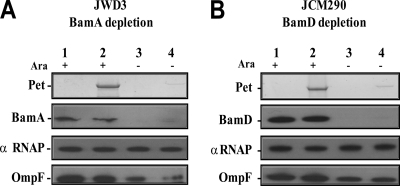Fig. 1.
BamA and BamD are required for Pet secretion. Shown are Coomassie blue-stained SDS-PAGE of trichloroacetic acid-precipitated supernatant proteins and Western blot analysis of whole-cell extracts from cultures of BamA depletion strain E. coli JWD3 (A) and BamD depletion strain E. coli JCM290 (B). In panel A, E. coli JWD3, carrying either the empty pSPORT1 vector (lanes 1 and 3) or pCEFN1 (lanes 2 and 4), was grown in LB medium containing 100 μg/ml ampicillin supplemented with either 0.2% l-arabinose (Ara) (+) or 0.2% d-fructose (−). In panel B, E. coli JCM290, carrying either pACYC184/pet (lanes 2 and 4) or the empty vector, was grown in LB medium containing 30 μg/ml chloramphenicol supplemented with either 0.05% l-arabinose (+) or 0.05% d-fructose (−). For both panels A and B, overnight cultures were diluted into a volume of 50 ml (OD600 = 0.025) and grown at 37°C with shaking for 3 h. Cultures were harvested, and supernatant proteins were precipitated with 10% trichloroacetic acid. BamA, BamD, and OmpF were detected using antiserum raised in a rabbit, and the α subunit of RNA polymerase (αRNAP) was detected using mouse monoclonal antibodies (Neoclone). Blots were developed using the ECL Plus Western blotting detection system (GE Healthcare). Like OmpF levels, under BamA and BamD depletion conditions, Pet levels are severely diminished whereas the levels of RNAP remain constant.

